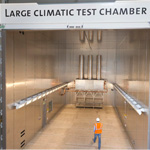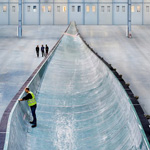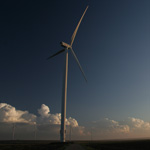 A large climatic chamber which can test offshore wind turbine components in extreme temperatures ranging from -60 degrees Celsius to +60 degrees was unveiled in Antwerp on Thursday as part of a new research and development facility.
A large climatic chamber which can test offshore wind turbine components in extreme temperatures ranging from -60 degrees Celsius to +60 degrees was unveiled in Antwerp on Thursday as part of a new research and development facility.
An element of the Offshore Wind Application Lab (OWI-Lab), the climate chamber, is housed inside a structure in Antwerp’s port area. It is capable of testing mechanical, hydraulic and electrical wind turbine components such as gearboxes, generators, yaw systems and transformers weighing up to 150 tonnes.
Typical activities will include design verification, component validation, prototype testing and cold start tests. In addition to the chamber, with dimensions of 10m x 7m x 8m, OWI-Lab will house the tools needed to perform a myriad of dedicated research and development tests.

Siemens new 75m turbine. Copyright Siemens
Two new technological developments in the global wind power industry have been garnering media interest recently as the emissions-free generating sector continues to increase its world-wide installed capacity year after year after year.
Siemens announced earlier in August that it had built, at 75 metres, the world’s largest rotor blade for wind turbines.
By way of comparison, and to understand just how long the new Siemens blade is, those who attended EWEA’s Annual Event in Copenhagen in April 2012 may remember that massive LM Wind Power 73.5-metre blade displayed outside the Bella Center.
 Much of the emphasis on green living today is all about scaling down: own a bike and not a SUV, for example. But when it comes to wind turbines a new study has found that the reverse is true: bigger turbines are better for the environment.
Much of the emphasis on green living today is all about scaling down: own a bike and not a SUV, for example. But when it comes to wind turbines a new study has found that the reverse is true: bigger turbines are better for the environment.
Since the founding of EWEA some 30 years ago (read more about our 30th anniversary here and look out for a special edition of Wind Directions magazine in September) turbine technology has been transformed. In 1982, turbine manufacturers were building 55kW turbines; today typical onshore turbines are around 3 MW, with the largest onshore turbines reaching a powerful 7 MW.
 Current wind turbine design is revolving around the 6 to 7 MW capacity range, with increasingly large rotor diameters.
Current wind turbine design is revolving around the 6 to 7 MW capacity range, with increasingly large rotor diameters.
But why go for a 7 MW turbine with a bigger rotor when a range of 3-5 MW designs are already available?
“There’s an offshore market kicking off,” Anders Bach Andersen of Vestas told Wind Directions magazine. “and in order to make that market reasonably competitive bigger turbines are needed. With bigger turbines you need fewer of them and you can reduce both capital and operating costs. But with fewer turbines you have potentially a smaller swept area at wind farm level so you need to compensate for that by equipping the machine with a larger diameter rotor.”
 France officially joined the offshore wind power sector on Tuesday with an announcement by President Nicolas Sarkozy that the government would initially invest more than €10 billion on sea-based wind farms off northern France.
France officially joined the offshore wind power sector on Tuesday with an announcement by President Nicolas Sarkozy that the government would initially invest more than €10 billion on sea-based wind farms off northern France.
About 10,000 jobs will be created in the French offshore wind energy sector, Sarkozy said, adding the first 600 wind turbines are to be installed in five areas off Normandy, Brittany and Loire-Atlantique.
“Our aim is to have an outstanding national sector emerge to build the means to produce these offshore wind turbines and to look towards exporting them,” Sarkozy was quoted as saying.
 A large climatic chamber which can test offshore wind turbine components in extreme temperatures ranging from -60 degrees Celsius to +60 degrees was unveiled in Antwerp on Thursday as part of a new research and development facility.
A large climatic chamber which can test offshore wind turbine components in extreme temperatures ranging from -60 degrees Celsius to +60 degrees was unveiled in Antwerp on Thursday as part of a new research and development facility.






 Comments
Comments



